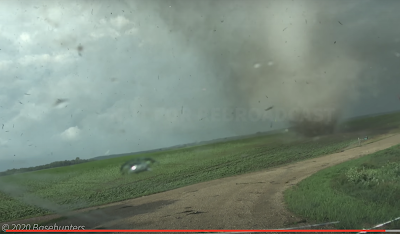One of the Most Amazing Tornado Videos, Ever -- A Candidate For Photogrammetry
Earlier this month, two major tornadoes occurred in Minnesota. The Basehunters (a storm chase team) posted their 4K video yesterday and there are things I believe are worth bringing to your attention.
The first is the ding to the windshield (below).
I believe that was caused by flying debris. It looks similar to a bullet strike. That is why we urge you not to take video of a tornado. If flying debris strikes you, you could be killed or seriously injured.
The second is the sound of the tornado.
I've heard many tornadoes and this is the first I've heard that sounds just like a jet engine. If you have ever been on the tarmac of a busy airport, you'll recognize the sound when the photographer steps out of the car. If you wish to watch this segment full screen, click here.
This tornado has the strongest, tightest rotation of any tornado I have personally seen or video/film that I have viewed. It would be valuable to know the windspeed of this tornado.
On April 2, 1957, a tornado struck north Dallas. A photogrammetry study was done on the video below, specifically the black and white segment (depicting flying debris) that begins when you start the clip.
In 1960, the journal Monthly Weather Review published the study (known as the "Hoecker Study") that calculated wind speeds of 170 mph in the horizontal and vertical wind speeds up to 150 mph. This would be an F-3 tornado on the original Fujita Scale. [When I tested the video last night, it worked fine. Now, it is requiring you to play it on YouTube from the beginning. The Hoecker Study portion begins at 1:00 and lasts until 1:16. Sorry for the inconvenience.]
To my knowledge, there was no research Doppler radar on this tornado. Even if there was, the circulation is so tight it probably could not be resolved.
The 4K video taken by The Basehunters has far more resolution than the Dallas film. So, I would urge that a photogrammetry study be done on this particular tornado to measure the wind speeds in the horizontal and the vertical. We might be surprised what we learn.
The first is the ding to the windshield (below).
I believe that was caused by flying debris. It looks similar to a bullet strike. That is why we urge you not to take video of a tornado. If flying debris strikes you, you could be killed or seriously injured.
The second is the sound of the tornado.
I've heard many tornadoes and this is the first I've heard that sounds just like a jet engine. If you have ever been on the tarmac of a busy airport, you'll recognize the sound when the photographer steps out of the car. If you wish to watch this segment full screen, click here.
This tornado has the strongest, tightest rotation of any tornado I have personally seen or video/film that I have viewed. It would be valuable to know the windspeed of this tornado.
On April 2, 1957, a tornado struck north Dallas. A photogrammetry study was done on the video below, specifically the black and white segment (depicting flying debris) that begins when you start the clip.
In 1960, the journal Monthly Weather Review published the study (known as the "Hoecker Study") that calculated wind speeds of 170 mph in the horizontal and vertical wind speeds up to 150 mph. This would be an F-3 tornado on the original Fujita Scale. [When I tested the video last night, it worked fine. Now, it is requiring you to play it on YouTube from the beginning. The Hoecker Study portion begins at 1:00 and lasts until 1:16. Sorry for the inconvenience.]
To my knowledge, there was no research Doppler radar on this tornado. Even if there was, the circulation is so tight it probably could not be resolved.
The 4K video taken by The Basehunters has far more resolution than the Dallas film. So, I would urge that a photogrammetry study be done on this particular tornado to measure the wind speeds in the horizontal and the vertical. We might be surprised what we learn.
Blog Post: © 2020 Mike Smith Enterprises, LLC





Comments
Post a Comment